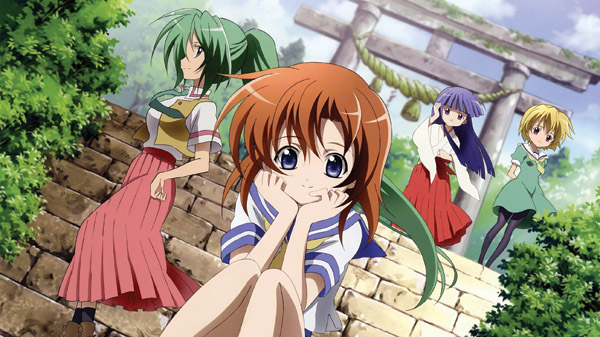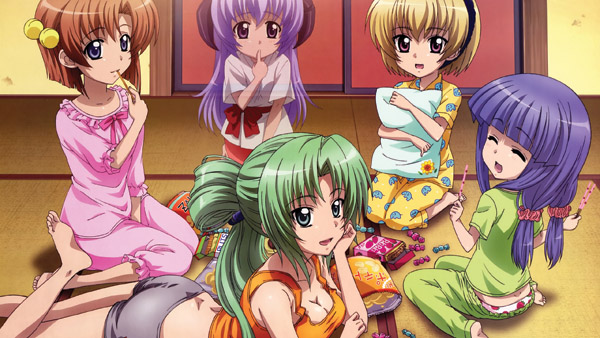
It’s June in 1983, and Keiichi Maebara has recently moved from Tokyo to Hinamizawa—a rural village steeped in superstition and inhabited by a tightly knit but relatively small population that’s quietly grown slightly smaller over the past few years. Initially, everything about Hinamizawa agrees with Keiichi: the fresh country air, the four friendly females who befriend him, and the generally hospitable small town vibe. But all too soon everything Keiichi takes for granted starts to unravel after a murder takes place on the night of the village’s Cotton Drifting Festival and the curse of the local deity, Oyashiro, takes hold. No one is safe from its wrath when sanity is in the eye of the accuser.
Not a series for the squeamish, the faint of heart, or those infuriated by mystery, When They Cry (Higurashi no Naku Koroni) starts with a thwack and goes out with a bang. These 26 episodes comprise six arcs that each start with a very sharp hook and collectively tell several linear tales of fear and suspicion in nonlinear fashion.

Sure, there’s on-screen violence and gore that’ll make even the most hardened horror veteran wince, but the storytelling really excels via the use of such classic horror devices as crowd hysteria, off-screen violence, facial reactions, setting, ambience, and good ol’-fashioned paranoia. All of this is further enhanced by a very calculated sense of building unease, which makes each tale (the tale) all the more engrossing.
Sporadic hints of something “off” in the beginning of each arc inevitably grow in number and obsession, episode by episode, until maniacally and maliciously acted upon. This pacing effectively evokes the maximum feeling of terror by continually corrupting the inherent innocence of the rural setting. But that corrosion does not always take the form of bloody violence.

Horror can take many forms, and the dimming of hope and the sense of sadness/helplessness that comes with it make one particular arc not only one of the most crushing but one of the scariest for all its realism. (Its companion arc in the second season nearly brought me to tears.) An atmosphere of oppression wouldn’t carry any weight, however, without the contrast of the daily lives of Hinamizawa residents and Keiichi’s friends: Rena Ryugu, Mion Sonazaki, Satako Hojo, and Rika Furude.
When They Cry was initially created by Ryukishi07 as a visual novel, which pretty much explains the male protagonist to female friend ratio (among other things). Toshifumi Kawase is responsible for the anime’s series composition and a good portion of the script (along with Rika Kawase), which is unfortunately reminiscent of clunky VN dialog in certain scenes.

This is most obvious when the decently sized cast of main characters responds individually within a group to some recent news about one thing or another and especially holds true when Keiichi receives reinforcement from the rest of the cast. In these instances, each character says roughly the same thing with a little variation in wording and sentiment based on their unique personality. Luckily, most of the anime thrives on suspicions aroused from being separated from the group, so most of the dialogue is fluid throughout.
While animation from Studio Deen shares some of that inconsistency, the right effects are always in place when and where they’re needed. The variations in quality and execution, like in the When They Cry manga (with each arc illustrated by different artists), can add unique aesthetics that lend to or define a scene’s tone.

Even among these, however, some effects come off as laughable (e.g., a certain someone’s face while shaking a ladder). Unfortunately, there are also a few instances where a less fine attention to detail, scale, etc. make it appear as though the budget had to be cut somewhere. When They Cry is not close to being a visual masterpiece, but Studio Deen definitely knew where and when to apply the magic to get the most creep for their yen.
While the visuals certainly enhance the experience, all one really needs to do to enjoy When They Cry is listen (which also explains its existence as a set of Drama CDs). Whether Japanese or English, the voice actors make threat-laden whispers, hauntingly foreboding warnings, and insane laughter just as believable as the day-to-day giggles, ribbings, and banter that dominate most episodes.

In particular regarding Geneon’s English dub, I’ve heard Rena’s voice criticized as overly squeaky and annoyingly high pitched. It is, in my opinion, over-the-top sugary sweet at times, but that’s all done for the contrast. Because when Rena gets serious and delivers a deadpan line or issues forth a psychotic shriek, chills will run down a viewer’s spine no matter how hot and humid summer is. The vocals, in truth, are not perfect at all times, but the range of emotions from the entire cast is spot on and leveraged to produce a memorable experience.
Not only does When They Cry go for the jugular, it goes for the heart. Its horrific images last long after the screen goes black, while the theme of friendship as a stabilizing force and sole hope for overcoming adversity makes one appreciate those who offer their trust so freely in everyday life. Unlike most horror anime, gore is used as a bloody punctuation mark to an intricately built tension, and this is what gives the series its resonant power. By having the characters snap, by having those snaps defined as failure, and by equating those failures with vivid brutality, this series turns what could easily be simple horror stories into a deeper tale of morality.

Infinitely enjoyable, When They Cry is one of those series where something new can be seen every time it’s watched. The series structure lends a lot to this, but some of the visuals (and even entire scenes) offer clues that are near impossible to pick up on during the first viewing and can be more fully appreciated upon subsequent visits to Hinamizawa. While these 26 episodes comprise one half of the series, they come, very neatly, to an acceptable and even deviously delicious stopping point. Ryushiki07 also wrote the manga and light novels. And although I haven’t read the latter, the manga (available from Yen Press) is worth purchasing even if you’ve seen the animated series because of how the format is leveraged, the use of black and white, and to find out ALL the answers.

